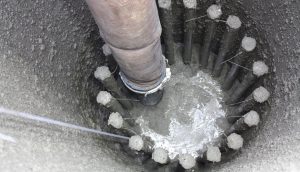A new vacuum excavation technique for piling has been unveiled which could have massive benefits for the wider construction industry in the UK and abroad. Developed by specialist contractors working on HS2, the pioneering new approach is better for the environment, safer for workers and reduces construction noise, to the benefit of neighbouring communities and businesses.

The “zero trim pile technique” involves sucking out excess concrete whilst still wet using a new vacuum excavator technique. Traditionally in piling, concrete is overpoured and then workers have to break out the excess concrete. This can cause a lot of health problems, including hand-arm vibration syndrome, hearing loss and silicosis. By removing the need to break out excess concrete, this new approach is safer for workers, and also reduces the manhours involved in complex piling work.
Whilst vacuum excavation technology is not new, using it in this way in the construction sector marks a step change, and initial trials have proved overwhelmingly successful. HS2 contractors developing innovative new methods to deliver the project saw a promising opportunity and found a willing supplier to invest in machinery to test the approach. Hercules Site Services, a company from Cirencester, were keen to develop the technology, and provided a machine for use on site in the Euston Approaches, for use on real life piles. Materials excavated were then sent off for lab testing and reports.
As well as having health and safety benefits and improving efficiency, the technique also reduces the noise from piling, which is hugely important for projects like HS2 where construction is taking place within communities and near operational businesses. Further, there are considerable cost savings and, done in the right way, there are environmental benefits, as the new technique uses less concrete. On HS2, the extracted concrete is retained and is being reused in construction elsewhere. Keeping the excess material on site and reusing it will reduce lorry movements to and from sites.